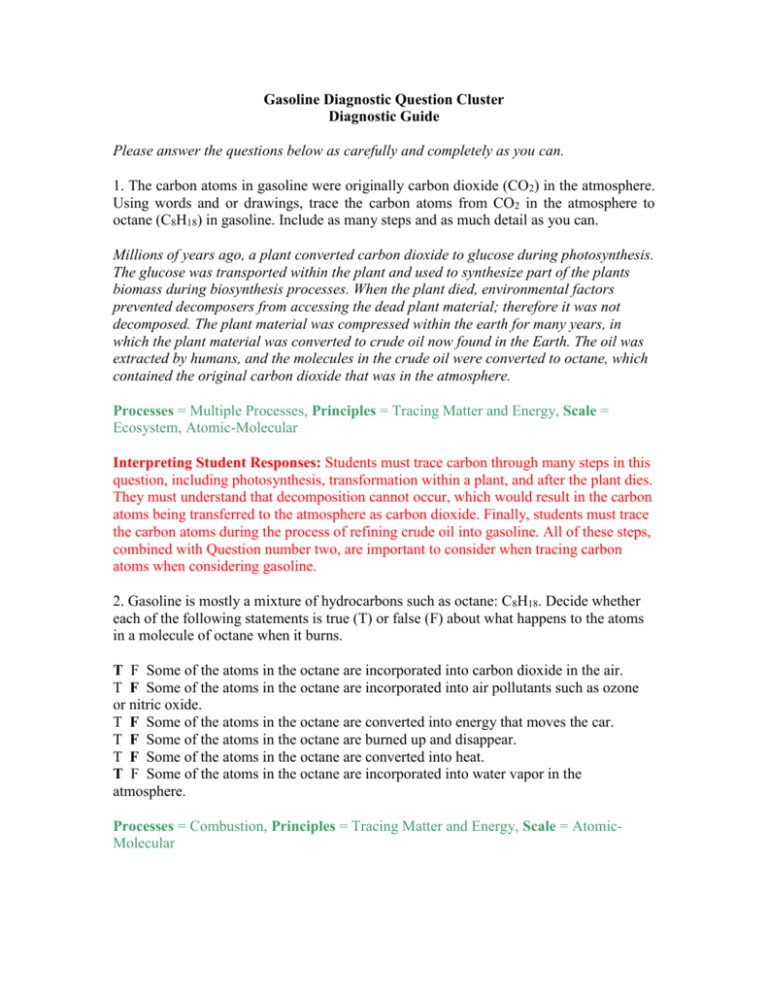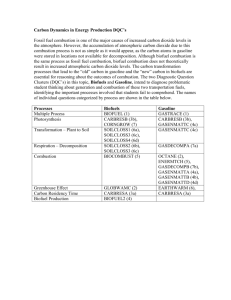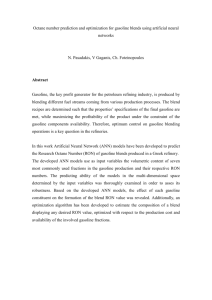Gasoline DQC_diagnosis - Thinking Like A Biologist
advertisement

Gasoline Diagnostic Question Cluster Diagnostic Guide Please answer the questions below as carefully and completely as you can. 1. The carbon atoms in gasoline were originally carbon dioxide (CO2) in the atmosphere. Using words and or drawings, trace the carbon atoms from CO2 in the atmosphere to octane (C8H18) in gasoline. Include as many steps and as much detail as you can. Millions of years ago, a plant converted carbon dioxide to glucose during photosynthesis. The glucose was transported within the plant and used to synthesize part of the plants biomass during biosynthesis processes. When the plant died, environmental factors prevented decomposers from accessing the dead plant material; therefore it was not decomposed. The plant material was compressed within the earth for many years, in which the plant material was converted to crude oil now found in the Earth. The oil was extracted by humans, and the molecules in the crude oil were converted to octane, which contained the original carbon dioxide that was in the atmosphere. Processes = Multiple Processes, Principles = Tracing Matter and Energy, Scale = Ecosystem, Atomic-Molecular Interpreting Student Responses: Students must trace carbon through many steps in this question, including photosynthesis, transformation within a plant, and after the plant dies. They must understand that decomposition cannot occur, which would result in the carbon atoms being transferred to the atmosphere as carbon dioxide. Finally, students must trace the carbon atoms during the process of refining crude oil into gasoline. All of these steps, combined with Question number two, are important to consider when tracing carbon atoms when considering gasoline. 2. Gasoline is mostly a mixture of hydrocarbons such as octane: C8H18. Decide whether each of the following statements is true (T) or false (F) about what happens to the atoms in a molecule of octane when it burns. T F Some of the atoms in the octane are incorporated into carbon dioxide in the air. T F Some of the atoms in the octane are incorporated into air pollutants such as ozone or nitric oxide. T F Some of the atoms in the octane are converted into energy that moves the car. T F Some of the atoms in the octane are burned up and disappear. T F Some of the atoms in the octane are converted into heat. T F Some of the atoms in the octane are incorporated into water vapor in the atmosphere. Processes = Combustion, Principles = Tracing Matter and Energy, Scale = AtomicMolecular Interpreting Student Responses: This question about gasoline combustion is a good complement to question 1 above, which asks about the origin of gasoline. You can consider these questions together as the multiple process question. Gasoline is combusted to release heat energy which is converted to mechanical energy. However, students don’t always trace matter during this process, often incorrectly converting matter to energy. In addition, many students believe that gasoline combustion results in higher emissions than biofuel combustion. Therefore, they don’t trace matter effectively, often because they convert matter to energy. We ask the same question about ethanol from biofuels in the Biofuels DQC. Incorrect student responses are found for all six true/false questions. Most commonly, students incorrectly convert matter to energy. 3a. On average, how long do you think a molecule of carbon dioxide remains in the atmosphere after being released by a human being? Anywhere between 2 and 20 years would be considered appropriate answers. Five – ten years is considered to be the average residence time for CO2 in the atmosphere. Processes = Carbon Residency Time, Principles = Tracing Matter, Scale = AtomicMolecular Interpreting Student Responses: The major reason for asking this question is to lead into question 3b. However, students don’t tend to recognize how long a molecule of carbon dioxide remains in the atmosphere before being transformed to organic carbon through photosynthesis or dissolving into a water body. In multiple choice format, students tend to choose either a 5 year, 50 year, or 350 million year residence time. Students providing very long time frames don’t appear to understand the path that carbon takes between the biosphere and atmosphere. 3b. After a period of time, the carbon atom released by a human being will leave the atmosphere. Where does the carbon atom go when it leaves the atmosphere? Carbon in the atmosphere is in the form of carbon dioxide. It leaves the atmosphere when a plant utilizes the molecule of carbon dioxide in photosynthesis. During this process, carbon dioxide is combined with water to form glucose, an organic carbon molecule. Processes = Photosynthesis, Principles = Tracing Matter, Scale = Ecosystem, AtomicMolecular Interpreting Student Responses: This question specifically asks students to recognize the process of photosynthesis without being explicitly asked about photosynthesis. Students may respond with answers that say carbon escapes the atmosphere, which incorrectly conserves matter. They may also say it is incorporated into animals during breathing, or dissolved into the Earth. They may also respond with an alternative correct answer that carbon dioxide dissolves into water bodies, and is converted to carbonate molecules, but this is unlikely unless they have learned this process. 4a. When you are riding in a car, the car burns gasoline to make it run. Eventually the gasoline tank becomes empty. What happened to the matter the gasoline was made of? The matter in the gasoline was converted to water vapor and carbon dioxide, both of which move to the atmosphere. 4b. When the gasoline tank became empty and the car stopped, where did the energy of gasoline go? The energy contained as chemical bond energy in the gasoline was transferred to mechanical energy that moved the automobile, and much of the energy was lost as heat. 4c. What was the ultimate source of energy for the gasoline? Sunlight, which was captured by plants millions of years ago, and stored as chemical bond energy as the plant material was compressed (not decomposed) over time. 4d. Do cars need air in order to run? Yes / No Please explain your answer. Air contains oxygen, which is a reactant during the process of gasoline combustion. Oxygen gas reacts with the gasoline to produce carbon dioxide and water. Processes = Combustion, Photosynthesis, Principles = Tracing Matter and Energy, Scale = Ecosystem Explicit Interpreting Student Responses: A series of questions ask students to trace matter and energy during the process of combustion. Questions 4a and 4b are good complements, that they require students to correctly separate matter and energy during combustion, and trace matter and energy after combustion. Tracing energy also requires knowledge of the source of energy – many students believe that energy is “created” during combustion – not correctly tracing energy from sunlight into gasoline and out as heat. 5. When a match burns the energy released A) comes mainly from the match. B) comes mainly from the air. C) is created by the fire. D) comes from the energy that you used to strike the match. E) none of the above Please explain your answer. When a match burns, the energy released is in the form of heat. This energy was previously in the form of chemical bond energy within the match, and was released when the bonds were broken during combustion. The ultimate origin of energy is sunlight, which is captured by plants and stored in the bonds within the plant. Processes = Combustion, Principles = Tracing Energy, Scale = Organismal Explicit Interpreting Student Responses: All responses – A, B, C and D – are common answers provided by students, with A being the least common response. Students know that air (oxygen) is needed for combustion, and often assume that the oxygen is also the energy source (Answer B). Answer C indicates unprincipled reasoning – that energy can be created spontaneously, and does not ultimately come from the sun. Striking the match is important for initiation of this energy transfer, but is not the energy source during the combustion of the match. 6. The atmosphere's ability to keep the surface of the earth warm is caused by the ... A) seasons. B) greenhouse effect. C) ozone layer. D) wind. E) Responses B. and C. are correct. Processes = Greenhouse Effect, Principles = Tracing Matter and Energy, Scale = Ecosystem Explicit Interpreting Student Responses: Students must understand the process by which climate change is occurring, as gasoline combustion results in carbon dioxide released to the atmosphere, which is a greenhouse gas and traps heat near the Earth’s surface. This question does not fit directly under the general principles of tracing matter or energy, but is essential to understanding of climate change due to fossil fuel combustion. Students may understand carbon cycling, but may fail to correctly answer multiple process questions due to limited knowledge of the greenhouse effect. Many students attribute climate change to the depletion of the ozone layer. Very few students choose D as the correct answer. 7a. Scientists have discovered several microorganisms that are able to decompose gasoline. What happens to the carbon atoms in the gasoline during decomposition? Decomposers convert the gasoline molecules to smaller gaseous molecules such as carbon dioxide and methane. Processes = Respiration, Principles = Tracing Matter, Scale = Atomic-Molecular Interpreting Student Responses: We ask this question to understand student ability to trace matter during decomposition, and that carbon atoms in gasoline are converted to either carbon dioxide or methane, which are gaseous forms of carbon. The form of carbon released to the atmosphere is irrelevant – it is more important that students trace the carbon to the atmosphere. Specifically, we want to know whether students consider decomposition of gasoline to be a different process than decomposition of organic plant material in soil, which is asked about in Question 6b of the Biofuels DQC. It is likely that many students will only provide answers that leave carbon in the soil, not emitting the carbon to the atmosphere. 7b. Do the carbon atoms following decomposition by microorganisms end up in a different location than if the gasoline was burned in a car? Circle Yes or No. Please explain your answer. Cellular respiration is the process by which decomposers break down solid carbon containing molecules. The products of cellular respiration are carbon dioxide and water, which are the same products of the combustion process if gasoline was burned in a car. Processes = Respiration, Combustion, Principles = Tracing Matter, Scale = AtomicMolecular Interpreting Student Responses: Both cellular respiration and combustion are processes that oxidize solid or liquid forms of carbon, but many students don’t consider these two processes to be similar. A student providing a correct answer would need to apply principled reasoning about tracing matter. Students that answer with “Yes” or incorrectly explain why they answered with “No” do not understand the processes of cellular respiration and combustion.








